October 2nd, 2016 § § permalink
HG’s e-mail pal, Charles Curran, the Florida gourmand, informed HG this morning that the Carnegie Delicatessen will close at the end of 2016. Not a victim of The Real Estate Monster. The Carnegie owns the building in which it is located. The closing doesn’t sadden HG. For some decades the Carnegie has catered to tourists. Prices have been high and the sandwiches have been unappetizingly huge. The Carnegie opened its doors in 1937 and immediately attracted a crowd of show biz types: press agents, song pluggers, comedians, bookies and other raffish denizens of the Broadway/Seventh Avenue/Carnegie Hall neighborhood. HG dined there frequently from 1951 to 1983 (the downhill slide began in the 80’s). HG also frequented the Stage Delicatessen (when Max Asnas was in charge) and the incomparable Lindy’s. Those were glory days for Jewish delicatessens with Reuben’s in the East 50’s, Gitlitz in the West 70’s, Katz’s on Houston Street and 2nd Avenue Deli on Second Avenue. And, of course, there were scores of good delis in the boroughs (with the exception of Staten Island). HG’s all time favorite was Reuben’s. Its Reuben sandwich and chicken in the pot were incomparable. Woody Allen’s “Broadway Danny Rose” is framed around a group of comedians, seated at a Carnegie Delicatessen table, chatting about a Broadway character. The film captures the ethos of the Carnegie in bygone days. And, the film is a nice bittersweet homage to low level show biz.
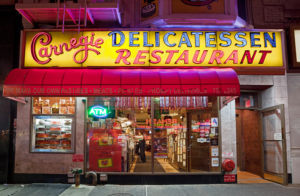
(Photo by James and Karla Murray)
September 25th, 2014 § § permalink
The old time New York Jewish waiter has disappeared. Nostalgia, of course, colors many memories of these flat-footed, bad tempered guys. They were not subservient. They did not introduce themselves: “My Name is Moisha. I’ll be your waitperson tonight.” They were not actors, directors, artists. They were career waiters and not happy about it. Most Jewish waiters disapproved of HG. At Gitlitz, located on Broadway and 79th, the best of all delicatessens, HG always ordered a sandwich that HG’s waiter considered an abomination: Pastrami and chopped liver on rye with Russian dressing. “You sure you want Russian dressing?” “Yes.” “Feh!!”, exclaimed the waiter. At the Paramount Dairy on W. 72nd Street HG would order warm gefilte fish in broth and wave away the proffered challah (egg bread). HG would accompany the fish with buttered onion rolls, undisturbed by critical glances. The Jewish waiter attitude was exemplified by a response HG received at Moscowitz and Lupowitz on the Lower East Side. “So, what’s good tonight?”. queried HG. “Whatever we got is too good for you.” The wonderful actor Fyvush Finkel, a stalwart of the Yiddish stage, was a long time customer at Cafe Royal on Second Avenue, the hangout of Yiddish actors, musicians, composers, directors, producers, press agents, playwrights, set designers and others connected with New York’s once vibrant Yiddish theater. Finkel always sat at one waiter’s table. He would watch some beautiful pot roast go by and order it. The waiter would shake his head. “Nem (take) deh chicken.” So, Finkel ate chicken. Went on for years. “Nem deh chicken.” Then Cafe Royal closed before he could taste the pot roast. Asked why he always sat at the waiter’s table, Finkel explained: “I am a masochist.”
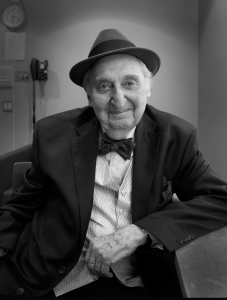
Photo Credit: Rivka S. Katvan
December 15th, 2013 § § permalink
When HG/BSK lived (with famille) in their spacious rent controlled paradise on New York’s W. 79th Street, HG would escape from the Christmas holiday jingles and saccharine melodies by visiting a stronghold of traditional Jewishness: Paramount Dairy Restaurant on W. 72nd. The stroll on Broadway during the Upper West Side’s pre-gentrification days was always interesting. HG passed culinary landmarks like Daitch Dairy, Babka Bakery, Izmir Pizza, Gitlitz Delicatessen, Citarella Fish Monger. Fellow strollers included junkies, female sex workers, muggers, burglars, crazy ladies talking to themselves, sad eyed refugees from the Nazi terror; and, the usual crowd of West Side intellectuals, artists, writers and bohemians. On almost every block, HG would pause for a chat with a friend or acquaintance. Once in the Paramount, HG was seated at a table adorned with a huge bowl of breadstuffs — each the best of its kind: rye and pumpernickel bread, bialys, pletzels, challah. A dozen pats of unsalted butter. No Christmas decorations. No Chanukah decorations (not even a minor league menorah). Very refreshing. HG would order warm gefilte fish (a note to the uninitiated–this is a fresh water fish dumpling, a Jewish quenelle). This was served in a bowl of fish broth with a boiled potato and carrot. Accompanied by blazing horse radish. HG would dip thick slices of challah in the fish broth. Very comforting. This was followed by kasha varnishkes with mushroom gravy (HG recently wrote about this dish). Many cups of coffee and overindulgence in buttered bialys and pletzels. Refreshed and Judaized, HG was then ready for another onslaught of Bing Crosby and “Silent Night.”
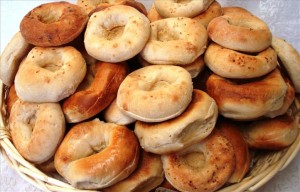
July 18th, 2013 § § permalink
In general, HG is not a big sandwich fan. Most of the time HG feels that most things that could be stuck between slices of bread are improved by eliminating the bread. However, there are exceptions and these days HG enjoys just a few classic sandwiches: A traditional bacon-lettuce-tomato (when tomatoes are in season — flavorful and juicy) with good, thick cut bacon and mayo on toasted wheat bread; a pastrami on Jewish rye (alas, now only available in all its splendor at Katz’s in New York, Schwartz’s in Montreal and Langer’s in L.A.); and finally, a corned beef Reuben, also on Jewish rye. The Croque Monsieurs and Croque Madames HG has enjoyed in Paris don’t really qualify as classic sandwiches. In the past HG was more adventurous in sandwich choices. On Nantucket Island, HG liked the specialty of a health food shop there: Sharp cheddar cheese, avocado, sprouts and chutney on whole grain bread. On the opposite health pole, HG relished the roast beef sandwiches consumed many years ago at Henrich’s Restaurant (long closed) on B. 116th Street, Rockaway Park, N.Y. These were constructed of thinly sliced rare roast beef, sliced raw onion and Jewish rye bread spread with (your choice) 1/8th or 1/4th of an inch of chicken fat. This was sprinkled with coarse salt and black pepper. Accompanied by a sour dill pickle. HG ate another unhealthy treat at the late Gitlitz Deli on New York’s Upper West Side. This was a combination of chopped liver and pastrami on rye with Russian dressing. The Gitlitz waiters, food conservatives, did not approve. At another long closed New York eatery, Belmont Cafeteria, the hangout for taxi drivers on Lexington Avenue, HG would accompany morning coffee with a heavily buttered onion roll enclosing muenster cheese and lettuce. In the past, BSK based her sandwich choices on peanut butter. No PB and J for BSK. Instead, the young woman ate peanut butter with lettuce and mayo sandwiches or peanut butter and sweet pickle slices sandwiches. While off on a hike with her Girl Scout troop, BSK carried “walking sandwiches” — peanut butter wrapped in cabbage leaves. Apparently these peanut buttery treats were the norm for BSK’s midwestern environ, but for HG, they sounded as exotic as the Zanzibar speciality Boku-Boku. Yes, many Italians love mixing Nutella with roasted peanuts on white bread and Elvis Presley mixed peanut butter with bacon and bananas but, for pure messy eccentricity, nothing beats the HG retro delight: The chow mein on a bun served at Nathan’s Famous on Coney Island.
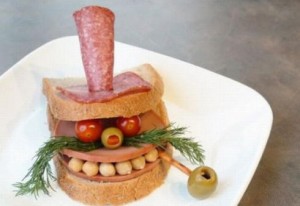
October 28th, 2012 § § permalink
The Vietnamese Bahn Mi (BBQ pork, a variety of pickled and fresh vegetables, Vietnamese pate. etc. on a baguette) has become a big winner among fanciers of sandwiches and Asian food. There are are many restaurants in New York specializing in this sandwich. Causes HG to sigh. With the demise of Jewish delicatessens the Banh Mi seems slated to replace the pastrami sandwich as the New York symbolic nosh. Sad. Best sandwich ever was the pastrami, chopped liver, cole slaw, Russian dressing sandwich on seeded rye served at the demised Gitlitz Deli on Broadway and 78th. This was closely followed by the Reuben (corned beef, sauerkraut, swiss cheese, Russian dressing, rye bread — grilled to molten perfection) at Reuben’s Delicatessen (long closed) on East 58th. Runner up was the rare room temperature sliced roast beef with thinly sliced raw onion and coarse salt on rye bread liberally coated with chicken fat. HG liked this at a delicatessen on Beach 116th Street, Rockaway Park. HG also fancied the muenster cheese and lettuce sandwich on an onion roll served at long shuttered cafeterias like The Belmore and Dubrow’s. HG is not just a parochial adherent of old style Jewish sandwiches. He has always fancied Cubanos, those pork and cheese sandwiches pressed upon a hot grill served at Cuban restaurants. HG often had one (accompanied by black beans and rice) at many Washington Heights hole-in-the-wall eateries. Good stuff. Those joints also served the best steaming cups of espresso.

October 10th, 2012 § § permalink
Some 48 years ago (seems like yesterday). HG, BSK, their two adorable children, their live-in mother’s helper and their poorly trained but decorative standard poodle, lived in a 12th floor Upper West Side apartment with dramatic views of the Hudson River and the New Jersey Palisades. A very spacious residence. Big living room. Big, separate dining room. Nice windowed kitchen and pantry. Four bedrooms and three baths (one en suite). The rent: $274 a month (later raised to $292 and a similar apartment in the same building now rents for $15,000 a month). Ah, rent control, you lovely bit of legislation (of course, obtaining this rent controlled paradise involved some bribery, chicanery and corruption). This did not shock HG, a born and bred New Yorker. In those days the Upper West Side was affordable and diverse. There was still a heavy Jewish influence. Big time theater and entertainment folks (Abe Burrows, Leonard Bernstein, Isaac Stern and many more) lived on Central Park West alongside many affluent professionals and business persons. Side streets from Central Park West to Broadway were gritty (except for W. 67th Street, site of the Des Artistes apartment house and many studios of painters and musicians). Riverside Drive and the Avenues and cross streets west of Broadway were filled with intellectuals and creative types who had more brains and talent than money. Forget Greenwich Village. The Upper West Side was the home of professors, critics, novelists, dancers, journalists, composers, actors, musicians and school teachers. Lots of European intellectuals who had fled Hitler and many Holocaust survivors (the little, pale, Nobel Prize winning writer, Isaac Baashevis Singer, who lived on W. 86th Street, often wrote about them). The Heresford (West Side apartment houses often had British names, a touch of Anglophile class) where HG and BSK lived, had much artistic ferment. Among its residents were Peter Boyle (before Hollywood and TV fame); film composer Michael Small, the critic and editor Ted Solotaroff; Gary Null, the health and sex writer, guru and radio personality. There were also some Broadway dancers, the cantor of a major synagogue and lesser artistic lights. The Upper West Side was filled with movie theaters showing art films (the New Yorker, Thalia and Symphony) and plus the first run houses (Loew’s 83rd, the Beacon,etc.). Food was a neighborhood obsession. Zabar’s, of course, but also Murray’s (preferred by some smoked fish aficionados) and Barney Greengrass (unsurpassed sturgeon). Middle European restaurants like Eclair and dairy restaurants like Steinberg’s and Paramount. Gitlitz’ Delicatessen on Broadway and 78th ( much superior in HG’s informed opinion, to Katz’s, Carnegie or 2nd Avenue Deli). The jewel of the West Side was the Tip Toe Inn (on Broadway near 86th Street). A huge place with a huge menu. Everything was delicious and inexpensive (the New York Public Library has a nice collection of old menus….Here’s a link to Tip Toe’s 1954 menu. Be astonished). There was a rotisserie in the Bretton Woods Hotel (86th and Broadway) that barbecued ducks and chickens. Sunday dinners for HG and BSK often featured one of those juicy, crisp skinned ducks and an avocado-sweet onion-sliced orange salad. Chinese restaurants were clustered around Broadway and 96th and they were very good (the first Szechuan restaurant in New York was on Broadway and 95th). There were also some Cuban/Chinese places where you could get good shrimp dishes plus Moros y Cristianos (black beans and rice) Fairway didn’t exist but for those who liked to eat at home there were butchers like Endicottt Meats and Nevada Market (where you could get some exotic stuff including bear, in season). Good bakeries. Mom and Pop greengrocers. Citarella’s for fish. Broadway Nut Shop for sweets. Daitch Dairy (79th and Broadway) for tub butter and cheese. Bretton Wood Rotisserie for barbecued ducks. HG and BSK were not plutocrats but could afford all of these good things. Yes, the Upper West Side had lots of junkies, hookers, muggers and burglars. Their presence made West Siders feel superior to residents of the antiseptic Upper East Side. Now, let HG make you young folks really jealous. HG, BSK and family spent all summer plus spring and fall weekends at their Fire Island home. Built atop a dune it had panoramic views of the Atlantic Ocean and Great South Bay sunsets. The family bought it for $40.000. HG’s first Fire Island house (in 1959) cost $4,000 ($1,000 for land and $3,000 for two bedrooms, bathroom, kitchen, living room and deck). In 1960, HG added two more bedrooms, another bathroom and additional decking. Cost: $2,000. That’s right. The numbers for these Fire Island properties are correct. Read and weep.
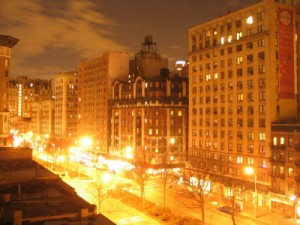
December 21st, 2011 § § permalink
It was 1963. HG and BSK were beginning their marriage in an artist’s studio apartment on West 67th Street just off Central Park West. Huge high ceilinged living room with north facing floor to ceiling window, small kitchen, small bedroom ( former model’s changing room), big bathroom with enormous tub. Very romantic. The rent: $140 per month.
This was The Golden Age Of Food On The Upper West Side. Gentrification and escalating real estate prices removed the gritty, funky luster. The neighborhood had junkies, muggers, burglars, hookers and bag ladies. It also had tons of artists, writers, academics and free ranging intellectuals lured by big apartments and cheap rents.
Here’s a smattering of the food and drinks establishments that delighted the newlyweds: 67th St. Wines (67th and Columbus): Splits of good champagne for a dollar. Volk’s German Restaurant (78th and Columbus): Bratwurst heaven. Fleur de Lis French Restaurant (65th off Broadway?): Escargots. Sole. Steak frites. C & L Restaurant (70th and Broadway?): Huge, Exceptional apple pancakes. Vast menu.  Tip Toe Inn (86th and Broadway). A sister restaurant to C & L with a great delicatessen. Also, notable chicken in the pot. Recently the Tip Toe Inn was featured on the show Mad Men and they were quite true to most of the original details. Zabar’s (81st and Broadway): Need HG say more? Now a New York landmark.
Tip Toe Inn (86th and Broadway). A sister restaurant to C & L with a great delicatessen. Also, notable chicken in the pot. Recently the Tip Toe Inn was featured on the show Mad Men and they were quite true to most of the original details. Zabar’s (81st and Broadway): Need HG say more? Now a New York landmark.

Zabar's Fish Counter
(87th and Amsterdam): Sturgeon and eggs with crisp fried onions.
Daitch Dairy (79th and Broadway): The best cream cheese.
Gitlitz (78th and Broadway): The unsurpassed Jewish delicatessen. A chopped liver and pastrami sandwich for the gods.
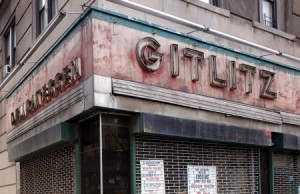 Nevada Market
Nevada Market (80th and Broadway): Steaks. Chops. Chicken.
Citarella’s (74th and Broadway): Everything fresh from the sea.
Paramount Famous Jewish Dairy Restaurant (72nd west of Broadway): Blintzes. Gefilte fish. Kasha varneshkes.
Steinberg’s (84th and Broadway): Same cuisine as Paramount but classier. Very good herring.
Great Shanghai (98th and Broadway) Chinese lobster and shrimp dishes. Dumplings.
Szechuan (95th and Broadway) Fire on a plate. New York’s first and best Szechuan restaurant.
Broadway Nut Shop. (East side of Broadway and 81st): Encyclopedic array of fresh roasted nuts, dried fruits and candy treats from across the globe.
Eclair Bakery and Restaurant (72nd Street): Vienna, Berlin, Budapest and Warsaw transplanted in New York.
Senate Cafeteria (96th and Broadway): Where I.B. Singer ate his tunafish salad in the company of tea sipping, Yiddish speaking European survivors.
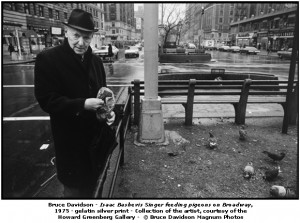
As HG remarked, this is just a smattering. There was much more. Sadly, only Zabar’s, Greengrass and Citarella’s remain. On the bright side: The West Side has added Fairway.









